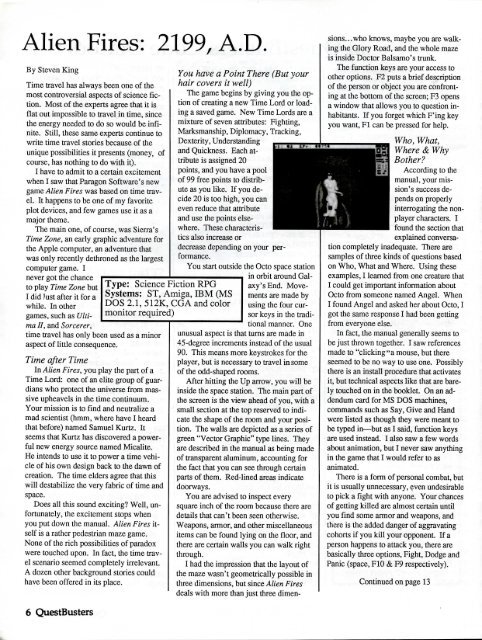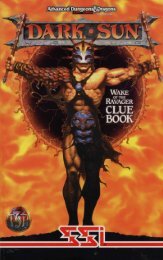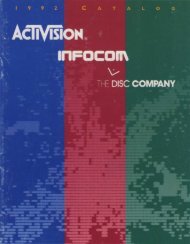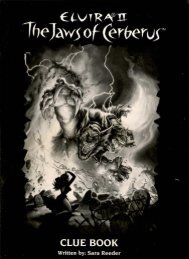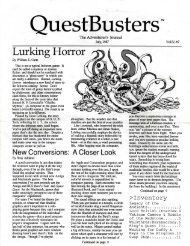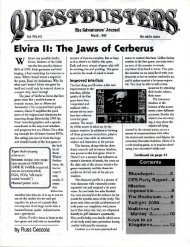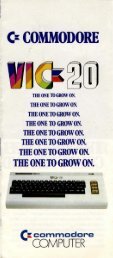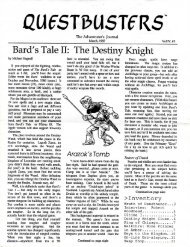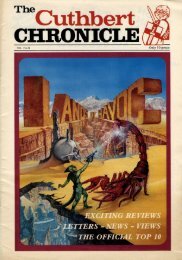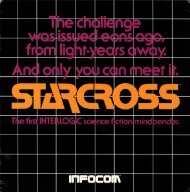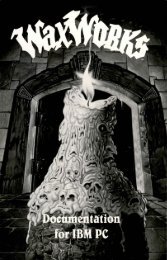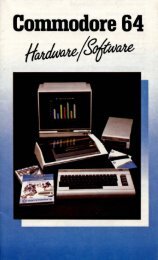Sentinel Worlds I: Future Magic - Museum of Computer Adventure ...
Sentinel Worlds I: Future Magic - Museum of Computer Adventure ...
Sentinel Worlds I: Future Magic - Museum of Computer Adventure ...
Create successful ePaper yourself
Turn your PDF publications into a flip-book with our unique Google optimized e-Paper software.
Alien Fires: 2199, A.D.<br />
By Steven King<br />
Time travel has always been one <strong>of</strong> the<br />
most controversial aspects <strong>of</strong> science fiction.<br />
Most <strong>of</strong> the experts agree that it is<br />
flat out impossible to travel in time, since<br />
the energy needed to do so would be infinite.<br />
Still, these same experts continue to<br />
write time travel stories because <strong>of</strong> the<br />
unique possibilities it presents (money, <strong>of</strong><br />
course, has nothing to do with it).<br />
I have to admit to a certain excitement<br />
when I saw that Paragon S<strong>of</strong>tware's new<br />
game Alien Fires was based on time travel.<br />
It happens to be one <strong>of</strong> my favorite<br />
plot devices, and few games use it as a<br />
major theme.<br />
The main one, <strong>of</strong> course, was Sierra's<br />
Time Zone, an early graphic adventure for<br />
the Apple computer, an adventure that<br />
was only recently dethroned as the largest<br />
computer game. I<br />
never got the chance<br />
to play Time Zone but<br />
I did Just after it for a<br />
while. In other<br />
games, such as Ultima<br />
II, and Sorcerer,<br />
time travel has only been used as a minor<br />
aspect <strong>of</strong> little consequence.<br />
Time after Time<br />
In Alien Fires, you play the part <strong>of</strong> a<br />
Time Lord: one <strong>of</strong> an elite group <strong>of</strong> guardians<br />
who protect the universe from massive<br />
upheavels in the time continuum.<br />
Your mission is to find and neutralize a<br />
mad scientist (hmm, where have I heard<br />
that before) named Samuel Kurtz. It<br />
seems that Kurtz has discovered a powerful<br />
new energy source named Micalite.<br />
He intends to use it to power a time vehicle<br />
<strong>of</strong> his own design back to the dawn <strong>of</strong><br />
creation. The time elders agree that this<br />
will destabilize the very fabric <strong>of</strong> time and<br />
space.<br />
Does all this sound exciting? Well, unfortunately,<br />
the excitement stops when<br />
you put down the manual. Alien Fires itself<br />
is a rather pedestrian maze game.<br />
None <strong>of</strong> the rich possibilities <strong>of</strong> paradox<br />
were touched upon. In fact, the time travel<br />
scenario seemed completely irrelevant.<br />
A dozen other background stories could<br />
have been <strong>of</strong>fered in its place.<br />
6 QuestBusters<br />
Type: Science Fiction RPG<br />
Systems: ST, Amiga, IBM (MS<br />
DOS 2.1, 512K, CGA and color<br />
monitor required)<br />
You have a Point There (But your<br />
hair covers it well)<br />
The game begins by giving you the option<br />
<strong>of</strong> creating a new Time Lord or loading<br />
a saved game. New Time Lords are a<br />
mixture <strong>of</strong> seven attributes: Fighting,<br />
Marksmanship, Diplomacy, Tracking,<br />
Dexterity, Understanding<br />
and Quickness. Each attribute<br />
is assigned 20<br />
points, and you have a pool<br />
<strong>of</strong> 99 free points to distribute<br />
as you like. If you decide<br />
20 is too high, you can<br />
even reduce that attribute<br />
and use the points elsewhere.<br />
These characteristics<br />
also increase or<br />
decrease depending on your performance.<br />
You start outside the Octo space station<br />
in orbit around Galaxy's<br />
End. Movements<br />
are made by<br />
using the four cursor<br />
keys in the traditional<br />
manner. One<br />
unusual aspect is that turns are made in<br />
45-degree increments instead <strong>of</strong> the usual<br />
90. This means more keystrokes for the<br />
player, but is necessary to travel in some<br />
<strong>of</strong> the odd-shaped rooms.<br />
After hitting the Up arrow, you will be<br />
inside the space station. The main part <strong>of</strong><br />
the screen is the view ahead <strong>of</strong> you, with a<br />
small section at the top reserved to indicate<br />
the shape <strong>of</strong> the room and your position.<br />
The walls are depicted as a series <strong>of</strong><br />
green "Vector Graphic" type lines. They<br />
are described in the manual as being made<br />
<strong>of</strong> transparent aluminum, accounting for<br />
the fact that you can see through certain<br />
parts <strong>of</strong> them. Red-lined areas indicate<br />
doorways.<br />
You are advised to inspect every<br />
square inch <strong>of</strong> the room because there are<br />
details that can't been seen otherwise.<br />
Weapons, armor, and other miscellaneous<br />
items can be found lying on the floor, and<br />
there are certain walls you can walk right<br />
through.<br />
I had the impression that the layout <strong>of</strong><br />
the maze wasn't geometrically possible in<br />
three dimensions, but since Alien Fires<br />
deals with more than just three dimen-<br />
sions. .. who knows, maybe you are walking<br />
the Glory Road, and the whole maze<br />
is inside Doctor Balsamo's trunk.<br />
The function keys are your access to<br />
other options. F2 puts a brief description<br />
<strong>of</strong> the person or object you are confronting<br />
at the bottom <strong>of</strong> the screen; F3 opens<br />
a window that allows you to question inhabitants.<br />
If you forget which F'ing key<br />
you want, Fl can be pressed for help.<br />
Who, What,<br />
Where & Why<br />
Bother?<br />
According to the<br />
manual, your mission's<br />
success depends<br />
on properly<br />
interrogating the nonplayer<br />
characters. I<br />
found the section that<br />
explained conversation<br />
completely inadequate. There are<br />
samples <strong>of</strong> three kinds <strong>of</strong> questions based<br />
on Who, What and Where. Using these<br />
examples, I learned from one creature that<br />
I could get important information about<br />
Octo from someone named Angel. When<br />
I found Angel and asked her about Octo, I<br />
got the same response I had been getting<br />
from everyone else.<br />
In fact, the manual generally seems to<br />
be just thrown together. I saw references<br />
made to "clicking"a mouse, but there<br />
seemed to be no way to use one. Possibly<br />
there is an install procedure that activates<br />
it, but technical aspects like that are barely<br />
touched on in the booklet. On an addendum<br />
card for MS DOS machines,<br />
commands such as Say, Give and Hand<br />
were listed as though they were meant to<br />
be typed in—but as I said, function keys<br />
are used instead. I also saw a few words<br />
about animation, but I never saw anything<br />
in the game that I would refer to as<br />
animated.<br />
There is a form <strong>of</strong> personal combat, but<br />
it is usually unnecessary, even undesirable<br />
to pick a fight with anyone. Your chances<br />
<strong>of</strong> getting killed are almost certain until<br />
you find some armor and weapons, and<br />
there is the added danger <strong>of</strong> aggravating<br />
cohorts if you kill your opponent. If a<br />
person happens to attack you, there are<br />
basically three options, Fight, Dodge and<br />
Panic (space, F10 & F9 respectively).<br />
Continued on page 13


